How Many Feet Are in a Story in a House?
Author: Omar Alonso | Editor: Omar Alonso
Review & Research: Jen Worst & Chris Miller

You may live in a three-story house or a two-story apartment where you live on the second floor. The word "story" has many meanings, but today we are focusing on how a story refers to buildings. Specifically how many feet are in a story.
How did a story become a word to describe building heights? How many feet equate to one story? What is the difference between a story within a building and a floor? What are homes like that only have half a story added to them?
Let's highlight the answers to these questions in the below paragraphs. Read this blog story to find out more information related to a story within a building.
How Many Feet Are Equal to One Story?

On average, according to ConvertUnits.com, one story is equal to about 10.826 feet (10.9 feet rounded up). Of course, the specific measurement of feet in a story depicts the structural height of its ceiling, how thick the floors are, and the material types utilized. Hence, a story can measure anywhere between 10.9 feet to 14 feet, depending on measurements about said factors.
The average 8-foot ceiling height for apartments, retail spaces, and free-standing homes can help us to calculate part of the measurement in feet for a story. Eight feet the average height of a ceiling, even though 9-foot ceilings have a significant perceived benefit to residents (and a massive cost increase). Ceiling thickness finalizes the calculation, too. The average thickness for drywall ceilings is about ⅝ inch.
The floor of a room within a level can be about ¾ inch thick, depending on the material. Hence, adding these values together equals 10 ⅜ inches. This value is close to the average range of a story in feet. Measurements vary with each factor based on overall construction planning for the home, apartment, or retail space in the community.
Let's look at the height of a story from a different angle. One story is about two men of the average height of 5 feet, 9 inches, stacked one on top of the other. So how tall is a two-story house? Double it to four men. I'll let you do the math.
Since 12 inches are in a foot, two people of this specific height, one on top of the other, equate to 11 feet, 6 inches, which is within the average range of story in the measurement of feet. Hence, if you are at least a few inches over five feet, your height alone measures about half a story. That's how many feet are in a story, or at least a way to calculate it more simply visually.
Word Origins Behind "Story"

In the modern English language, the word story has two meanings as a noun. One of the meanings says that a story is a type of measurement to describe a building’s height, such as whether you are in a one-story, two-story, or three-story building. The other meaning describes a story as a narrative of some kind, whether a formally published fictional or biographical work or a falsehood someone creates.
The etymology behind the word story has roots in Old French when talking about narratives and in Latin when discussing the height of buildings. Stories are narratives surfacing in the early language in about 1200 from the Old French word, estorie, which translates to story or chronicle. Roots are also from the Latin word historia which means tale or history.
The Anglo-Latin term, historia was also used to reference the height of a building starting in the 1400s. The story of a building was used to differentiate the location and height of the different rows of painted and decorated windows prominent in the Middle Ages on the front of various buildings.
Since most people did not know how to read back in the Middle Ages, drawing and painting pictures on the side of their homes and community buildings communicated stories to one another. Hence, the painted “story” on the sides of buildings hundreds of years ago eventually started becoming a way to describe a measurement of a building’s height.
How Stories Can Describe a Building

Understanding the history behind the word story and how it describes the height of a building can help to correctly identify whether part of a building is a floor or a story. While the two words are used the same in the everyday English language, they have different meanings that make them unique from one another.
Usually, if you have a one-story home, you have one floor with no upstairs or downstairs. However, the words story and floor do have different usages in the English language for their overall unique meanings and references.
What is the Difference Between a Story & a Floor?
A story (spelled as storey when writing it in British English) refers to how a building looks when you view it on the outside. Depending on how many rows of windows you see, you can easily discover how many stories make up the building. When people ask how many feet are in a story, they're not referring to the interior height, which would be called a floor.
For example, if you see three rows of windows, you can make an educational inference that you are looking at a three-story building. Each story of a building should have at least one or more windows to let some sunlight in, so counting window rows is a good start on calculating the number of stories on a building.
The level which you are currently on inside the building describes which floor you are. For example, if you are in an upstairs two-bedroom apartment and your apartment building has upstairs and downstairs units, that means you are on the second floor.
Alternatively, if you have three floors in your home, you will have a downstairs, a mid-level, and an upstairs level. Your master bedroom may be on the first floor, while you have one bathroom on each floor.
The stories in a home are typically different heights, but if you're wondering how many feet is a story in a building, you can have a consistent measurement (though the first story is often taller in the more gigantic buildings).
What is a Half Story?

A half story involves one of your floors having living space at the top of your home, but the roof is sloped to one side. Hence, you don’t have as much space as a regular story on that floor. For example, you may have an upstairs room that is about half the size of your downstairs room because the upstairs one is where the sloped roof is located.
Homes with a half-story also have dormer windows, which are vertically rectangular and push outward rather than upward like standard home windows. Dormer windows reassure that there is enough usable space within this half-story area of the home.
Whether you use the half-story area as types of rooms such as a finished bedroom, loft, or storage attic, it will be inhabitable for as long as you are in the space because of how it is constructed. A half story can often give you clues as to when your house was built, too, as they were only popular during certain decades.
Is a 1.5-Story Home Cheaper to Build Than a Two-Story Home?
Crazy enough, a 1.5-story home can cost more to build than a two-story home despite having half a story less in its overall build. A 1.5-story home involves utilizing a stick frame process that is more costly a procedure than the usual truss process of constructing a two-story home.
The time that it takes to do the truss process on two-and-a-half standard homes is the same amount of time spent doing the stick frame procedure on a 1.5-story home. Hence, the increased labor time expired is the reasoning behind stick framing being more expensive than installing trusses.
So, How Many Feet are in a Story?

How many feet are there per story in a building? Again, a story can range from 10.9 feet to 14 feet, depending upon the measurements of the ceiling and floor thickness of the materials utilized for the building. The measurement in feet of a story in the apartment complex that your friend lives in may more than likely be different that the measurement in feet of a story in your two-story home.
If you want to test an apartment complex manager or a homeowner selling their property, ask how many feet are in one story of their buildings. This question will get them to think critically so you can see if they know the ins and outs of their property.
So, One Story Equals How Many Feet?
Now you know the measurement of feet in a story. Whether you are an aspiring homeowner ready to work with building contractors to build your dream home’s floor plan or a construction worker wanting to learn more about your trade, we hope this information has helped you learn something new.
So how many feet are in a story? Go collaborate with your construction team and family members to get a building story going that will eventually become yours forever home!



